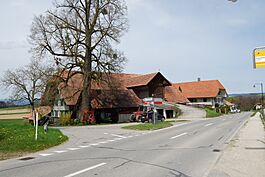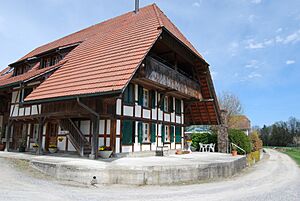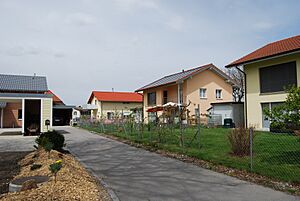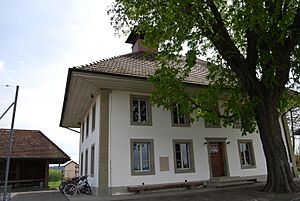Kriechenwil facts for kids
Quick facts for kids
Kriechenwil
|
||
|---|---|---|
 |
||
|
||
| Country | Switzerland | |
| Canton | Bern | |
| District | Bern-Mittelland | |
| Area | ||
| • Total | 4.74 km2 (1.83 sq mi) | |
| Elevation | 530 m (1,740 ft) | |
| Population
(Dec 2020 )
|
||
| • Total | 441 | |
| • Density | 93.04/km2 (241.0/sq mi) | |
| Postal code |
3179
|
|
| Surrounded by | Bösingen (FR), Ferenbalm, Gurmels (FR), Kleinbösingen, Laupen, Ulmiz (FR) | |
Kriechenwil is a small town, also called a municipality, in Switzerland. It is located in the Bern-Mittelland area within the canton of Bern.
Contents
History of Kriechenwil
Kriechenwil was first written about in 1353. Back then, its name was Digki. The town kept this name until 1959.
Early Settlements and Bernese Rule
People lived in this area a very long time ago. We know this from old finds like a spearhead from the neolithic period (New Stone Age). There was also a Hallstatt burial mound and some early medieval horse gear.
The land where Kriechenwil is now was once part of a medieval territory called Herrschaft of Laupen. This means it was ruled by a local lord. In 1324, the city of Bern took control of this entire area. Kriechenwil might have existed before this, but we don't have records from that time. Around 1400, a bridge was built over the Sarine river. This bridge was important for a trade route leading to Bern.
Religious Changes and Modern Life
The village used to be part of the parish of Neuenegg. A parish is like a church district. After the Protestant Reformation in 1528, Kriechenwil became part of the Laupen parish. This was when many parts of Europe changed from being Roman Catholic to Protestant.
Today, Kriechenwil has its own primary school for younger students. Older students travel to Laupen for their secondary education. About two-thirds of the people who work in Kriechenwil travel to jobs in nearby towns.
Geography of Kriechenwil
Kriechenwil covers an area of about 4.8 square kilometers (1.85 square miles). A large part of this land, about 54.5%, is used for farming. Forests cover 40% of the area. The rest of the land, about 5.5%, has buildings or roads. A very small part, 0.2%, is made up of rivers or lakes.
Most of the forested land is covered with thick forests. On the farms, 42.1% of the land is used for growing crops. Another 10.7% is used for pastures where animals graze. A small part, 1.7%, is used for orchards or growing grapes. All the water in Kriechenwil is from flowing rivers.
Kriechenwil is located on the Saane River. It is in the central Swiss plateau, which is a flat area in Switzerland. The town is right on the border with the Canton of Fribourg. Kriechenwil includes the main village and two smaller settlements called hamlets: Schönenbühl and Risau.
In 2010, Kriechenwil joined a new administrative area called Verwaltungskreis Bern-Mittelland. Before that, it was part of a different district called Amtsbezirk Laupen.
Kriechenwil's Coat of Arms
A coat of arms is a special design that represents a town or family. Kriechenwil's coat of arms has a green linden tree on a silver background. Next to it, there's a blue section with three wavy silver lines. These lines are outlined in black.
People of Kriechenwil (Demographics)
Kriechenwil has a population of about 414 people (as of December 2011). In 2010, about 3.6% of the people living here were foreign nationals. Over the past ten years (2001-2011), the population has grown slightly, by about 0.7%. Most of this growth came from people moving into the town.
Languages Spoken
Most people in Kriechenwil speak German. In 2000, about 96.6% of the population spoke German as their main language. French was the second most common language, spoken by 1.7% of the people. A small number of people, 1.2%, spoke one or more African languages.
Where People Come From
In 2008, about 53% of the population was male and 47% was female. Most people in Kriechenwil were born either in the town itself or in the same canton (Bern). In 2000, about 36.3% of the people were born in Kriechenwil. Another 37.8% were born in the canton of Bern. About 18.5% were born elsewhere in Switzerland, and 4.9% were born outside of Switzerland.
Age Groups and Households
As of 2011, young people (0–19 years old) make up 18.4% of the population. Adults (20–64 years old) make up 54.8%, and seniors (over 64 years old) make up 26.8%.
In 2010, there were 39 households with only one person. There were 17 households with five or more people. Most apartments in Kriechenwil are lived in all the time.
Population Changes Over Time
The chart below shows how the population of Kriechenwil has changed over many years:

Economy of Kriechenwil
In 2011, the unemployment rate in Kriechenwil was very low, at 1.05%. This means almost everyone who wanted a job had one. In 2008, there were 114 people working in the town.
Main Job Sectors
Jobs are usually divided into three main groups:
- Primary sector: This includes jobs that get raw materials from nature, like farming or forestry. In Kriechenwil, 57 people worked in this sector, mostly in agriculture. There were 19 businesses in this area.
- Secondary sector: This includes jobs that make things, like manufacturing or construction. In Kriechenwil, 25 people worked in this sector, with 4 businesses. Most of these jobs were in manufacturing.
- Tertiary sector: This includes jobs that provide services, like shops, restaurants, or schools. In Kriechenwil, 32 people worked in this sector, with 12 businesses. Examples include sales, transportation, hotels, and education.
In 2008, there were 74 full-time equivalent jobs in Kriechenwil. This means if you add up all the hours worked by full-time and part-time employees, it would be like having 74 full-time workers.
Commuting and Taxes
Many people who live in Kriechenwil travel to other towns for work. In 2000, 136 people commuted out of the municipality for their jobs. Only 31 people came into Kriechenwil to work. This means more people leave Kriechenwil for work than come in. About 68 people both lived and worked in Kriechenwil.
When people travel to work, 14.2% used public transportation, and 50% used a private car.
In 2011, the average tax rate for a married person in Kriechenwil earning 150,000 CHF (Swiss Francs) was 12.2%. For an unmarried person, it was 17.9%. These taxes help pay for public services in the town and canton.
Religion in Kriechenwil
Based on a survey from 2000, most people in Kriechenwil belong to the Swiss Reformed Church. About 84.9% of the population followed this faith. Another 7.8% were Roman Catholic. A small number of people belonged to other Christian churches (1.95%) or were Islamic (1.46%). Some people were Buddhist (0.49%). About 2.68% of the population did not belong to any church, or were agnostic (not sure if God exists) or atheist (do not believe in God).
Education in Kriechenwil
In Kriechenwil, about 59.8% of adults have finished non-mandatory upper secondary education. This means they went to school past the basic required years. Also, 14.5% have completed higher education, like going to a university.
The School System in Bern
The school system in the Canton of Bern works like this:
- One year of optional Kindergarten.
- Six years of Primary school.
- Three years of required lower Secondary school. In this stage, students are grouped based on their abilities.
- After lower Secondary, students can choose to continue their education or start an apprenticeship (learning a trade on the job).
Kriechenwil's Schools
During the 2011-2012 school year, 14 students attended classes in Kriechenwil. There were no kindergarten classes in the town. Kriechenwil had one primary class with 14 students.
In 2000, 31 students attended school in Kriechenwil. Most of them (29) lived and went to school in the town. Only 2 students came from other towns to study there. In the same year, 27 students from Kriechenwil went to schools outside the municipality.
See also
 In Spanish: Kriechenwil para niños
In Spanish: Kriechenwil para niños







